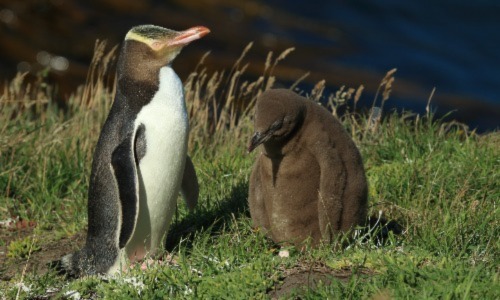From Lotus flowers to fishy mouths to the Mariana Trench: explore this month's diverse microbial discoveries
Posted on March 7, 2023 by Clare Baker
Each month, the Microbiology Society publishes the International Journal of Systematic and Evolutionary Microbiology, which details newly discovered species of bacteria, fungi and protists. Here are some of the new species that have been discovered and the places they've been found.
This month we are starting somewhere a little bit fishy; the mouths of yellow-eyed penguin chicks in New Zealand. Here we find two strains of Corynebacterium which together represent a novel species, Corynebacterium megadyptis. The unfortunate penguin chicks that manage to be infected by C. megadyptis suffer from infectious lesions in their mouth, producing a thick cream coloured fluid. This makes it hard for the ill-fated chicks to swallow food, resulting in exhaustion and significant weight loss due to malnutrition and sadly an untimely death.

Yellow-eyed penguins in New Zealand. iStock/Frank Fichtmüller
From the coastline we move out into the deep blue, the very deep blue in fact. This is where we find our next novel microorganism. Abyssibius alkaniclasticus was isolated from a deep-sea sediment sample collected from the Mariana Trench. This aquatic bacterium was found at a whopping -11,000m and is named Abyssibius alkaniclasticus after its ability to degrade alkanes. Not surprisingly, the bacterium is a member of a family that often thrives in marine environments. These bacterium benefit from sulphur and carbon biogeochemical cycling in a symbiotic relationship between aquatic micro- and macro-organisms.
From the dark of the deep sea to somewhere a little brighter. A novel bacterium, Thermomonas paludicola was isolated from a lotus wetland in the republic of Korea. Freshwater wetlands are ecologically important terrestrial aquatic environments owing to their high productivity, nutrient recycling capacity and significant contribution to global greenhouse gas emissions. This novel bacterium gets its species name paludicola from ‘palus’, meaning a swamp or bog and ‘cola’ meaning inhabitant or dweller. Interestingly, the genus name Thermomonas refers to the thermophilic (living at a high temperature) characteristics of the first discovery within the genus - T. haemolytica. This bacterium grew at 27–50°C but, aside from a few exceptions, the majority of this genus grow at 28–37 °C.
Sticking with flowers, but this time in South Australia. Here, five novel lactic acid bacterial strains, Fructilactobacillus cliffordii, Fructilactobacillus hinvesii, Fructilactobacillus myrtifloralis, Fructilactobacillus carniphilus and Fructobacillus americanaquae were isolated from various locations across Kangaroo Island. Lactic acid bacteria can be found in a variety of niches and have been variously classified as free-living, nomadic and host adapted. This time, they were found on flowers and insects, such as honey bees, meat ants and the flower of a smooth fringe-myrtle (Calytrix glaberrima) from the De-Tong Ling Buddhist Retreat Centre in Gosse.
And finally, how about we move the spotlight to yeast after a bacteria-heavy month? Hannaella floricola is a novel yeast species isolated from a flower of Lantana camara. This yeast was discovered during a survey of floricolous yeasts (yeasts that are associated with flowers) in Portugal. It’s assignment to the genus Hannaella was evident after DNA analysis of the novel yeast. Members of the genus Hannaella are found mostly in association with plants, especially plant leaves. This novel yeast shares this association although it was isolated from a flower, not a leaf. In fact, floricora, the yeast’s species name, is derived from this characteristic, meaning a dweller of flowers. It is not possible at present for researchers to identify if H. floricola has an ecological preference to flowers, or if its isolation from a flower was a mere consequence of a primary association with plant leaves. However, this work, combined with the results of another recent study of yeasts in floral nectar of tropical plants might indicate that floral nectar is a natural habitat of some species of Hannaella.
